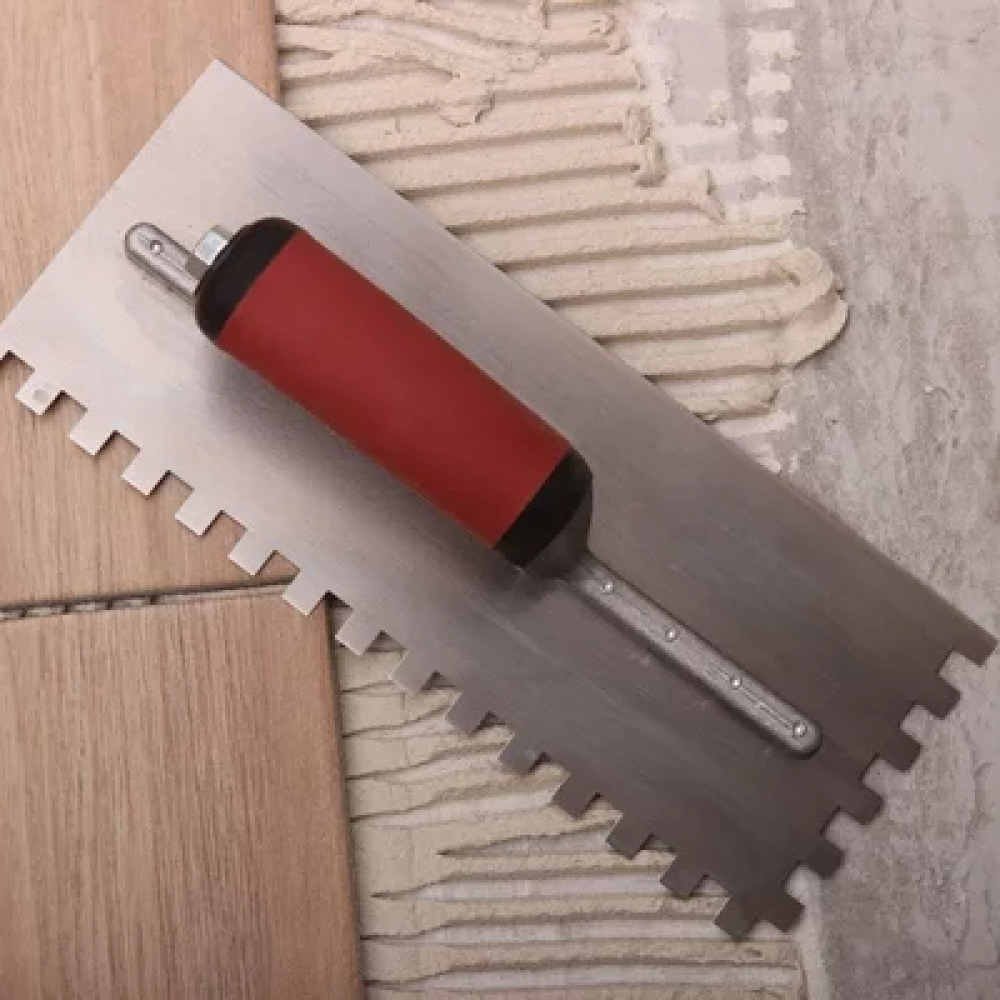Choosing the right ruler is important and should be done carefully before installing tiles. Some common questions to consider are:
1- What is the difference between a square ruler and a U-shaped ruler?
2- What is the best size to use?
3- Does the size and type of tiles affect the size of the trowel used in installation?
How much mixture will the trowels leave at the bottom of the tiles?
The size of the trowel determines how much weight to put on the mixture, as well as how thick the mixture layer should be at the bottom of the tile. When using square trowels of the same size and teeth (1/2 inch x 1/2 inch), the mixture will be half that measurement, or 1/4 inch, at the bottom of a flat tile on a flat substrate.
When you completely include the tile on the mix bed, it spreads the edges of the mix evenly into the spaces between the trowel lines. Since the spaces between the edges are the same size as the edges, this will divide the height of the edges in half. So a 1/2" x 1/2" trowel will leave 1/4" of mix under the tile. A 3/8" x 3/8" trowel will leave 3/16" of mix under the tile.
Using two U-trowels and tamping the tiles into the mix leaves the mix under the tiles just over 1/3 the size of the trowel teeth. So two 3/8" U-trowels leave 1/8" of mix at the bottom of the installed tiles.
Do you prefer square or U-shaped rulers?
Since two 10mm U-shaped trowels and two 6mm square trowels will leave a 3mm layer of thin mix under the installed tiles, what is the difference between them?
The difference in the shapes of the trowel teeth determines how easily the tiles will adhere and blend into the mix. It is easier to move the tiles in the mix when using U-shaped trowels.
On the other hand, using two U-shaped trowels results in the crack spreading when the tiles are installed on the mix with less potential for air trapping.


What size ruler do you prefer to use?
The correct size of trowel is one that gives you complete coverage at the bottom of the tile. This is confirmed by visual testing by lifting the tile after installation to ensure the amount of contact and coverage of the mixture with the tile. There should be no lines on the trowel and you will see complete coverage of the mixture on the back of the tile and plaster.
The right size of trowel for laying tiles depends on both the tile and the grout. The less flat the tile is (not level), the more grout it will need to be which means a larger trowel size.
Final installation requires a minimum of 3/32" mix. The 1/8" minimum makes it easier to calculate the proper size of tile trowel.
Calculating the appropriate amount of cupping
Find out by placing the tiles face to face and pressing on one corner. If the tiles are tiled, the opposite corner will not be face to face, but will be spread apart. Measure the amount of space between the faces of the tiles in the opposite corner and then divide that number in half. That is the volume of the tile.
If pressing the tile this way produces a 1/4" gap between the tiles in the opposite corner, the tile is 1/8" crimped. You should add this amount to the minimum amount you want under the tile in order to get proper coverage!
If you want a minimum of 1/8 inch mix at the bottom of the 1/8 inch tile, you should use two trowels to leave a 1/4 inch mix. Using two half inch square trowels will give adequate coverage.
Visual test: This is simply to ensure that the tiles are fully incorporated into the mixture. This is done by lifting the tiles after installation to ensure the amount of contact and coverage of the mixture with the tile.
Personal choice
To get a good result in the final installation, you must use the appropriate method to get adequate coverage. You can choose the ruler that suits you and that you prefer to use for different types of installation.
As a general rule, the larger the tile, the larger the trowel. For best results, make sure there is enough mix at the bottom of the tile.
The choice between a U-shaped ruler and a square ruler is up to you.
It is easiest to get full coverage using two U-shaped trowels, but you must also use two larger U-shaped trowels to achieve the same bed thickness under the tile. This is difficult to do in vertical installations so it is easier to do it with two square trowels with small teeth.
Proper mix coverage means a minimum of 85% total coverage under tiles in dry areas (most floors, fireplaces, etc.) and a minimum of 95% total coverage in wet areas (showers, sinks, etc.).

